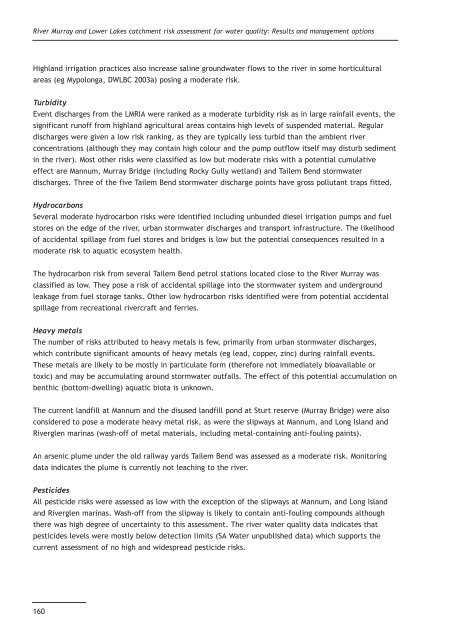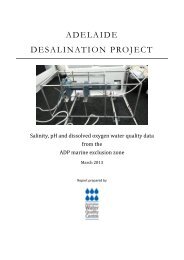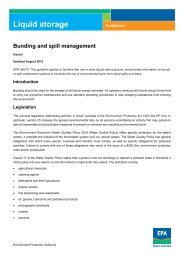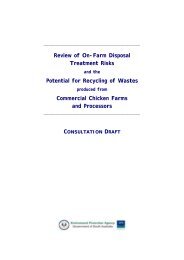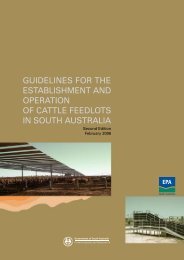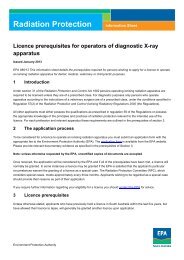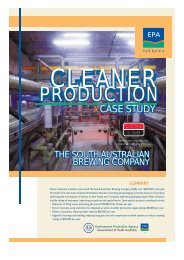2 Renmark to border LAP area assessment - EPA - Sa.gov.au
2 Renmark to border LAP area assessment - EPA - Sa.gov.au
2 Renmark to border LAP area assessment - EPA - Sa.gov.au
You also want an ePaper? Increase the reach of your titles
YUMPU automatically turns print PDFs into web optimized ePapers that Google loves.
River Murray and Lower Lakes catchment risk <strong>assessment</strong> for water quality: Results and management options<br />
Highland irrigation practices also increase saline groundwater flows <strong>to</strong> the river in some horticultural<br />
<strong>area</strong>s (eg Mypolonga, DWLBC 2003a) posing a moderate risk.<br />
Turbidity<br />
Event discharges from the LMRIA were ranked as a moderate turbidity risk as in large rainfall events, the<br />
significant runoff from highland agricultural <strong>area</strong>s contains high levels of suspended material. Regular<br />
discharges were given a low risk ranking, as they are typically less turbid than the ambient river<br />
concentrations (although they may contain high colour and the pump outflow itself may disturb sediment<br />
in the river). Most other risks were classified as low but moderate risks with a potential cumulative<br />
effect are Mannum, Murray Bridge (including Rocky Gully wetland) and Tailem Bend s<strong>to</strong>rmwater<br />
discharges. Three of the five Tailem Bend s<strong>to</strong>rmwater discharge points have gross pollutant traps fitted.<br />
Hydrocarbons<br />
Several moderate hydrocarbon risks were identified including unbunded diesel irrigation pumps and fuel<br />
s<strong>to</strong>res on the edge of the river, urban s<strong>to</strong>rmwater discharges and transport infrastructure. The likelihood<br />
of accidental spillage from fuel s<strong>to</strong>res and bridges is low but the potential consequences resulted in a<br />
moderate risk <strong>to</strong> aquatic ecosystem health.<br />
The hydrocarbon risk from several Tailem Bend petrol stations located close <strong>to</strong> the River Murray was<br />
classified as low. They pose a risk of accidental spillage in<strong>to</strong> the s<strong>to</strong>rmwater system and underground<br />
leakage from fuel s<strong>to</strong>rage tanks. Other low hydrocarbon risks identified were from potential accidental<br />
spillage from recreational rivercraft and ferries.<br />
Heavy metals<br />
The number of risks attributed <strong>to</strong> heavy metals is few, primarily from urban s<strong>to</strong>rmwater discharges,<br />
which contribute significant amounts of heavy metals (eg lead, copper, zinc) during rainfall events.<br />
These metals are likely <strong>to</strong> be mostly in particulate form (therefore not immediately bioavailable or<br />
<strong>to</strong>xic) and may be accumulating around s<strong>to</strong>rmwater outfalls. The effect of this potential accumulation on<br />
benthic (bot<strong>to</strong>m-dwelling) aquatic biota is unknown.<br />
The current landfill at Mannum and the disused landfill pond at Sturt reserve (Murray Bridge) were also<br />
considered <strong>to</strong> pose a moderate heavy metal risk, as were the slipways at Mannum, and Long Island and<br />
Riverglen marinas (wash-off of metal materials, including metal-containing anti-fouling paints).<br />
An arsenic plume under the old railway yards Tailem Bend was assessed as a moderate risk. Moni<strong>to</strong>ring<br />
data indicates the plume is currently not leaching <strong>to</strong> the river.<br />
Pesticides<br />
All pesticide risks were assessed as low with the exception of the slipways at Mannum, and Long Island<br />
and Riverglen marinas. Wash-off from the slipway is likely <strong>to</strong> contain anti-fouling compounds although<br />
there was high degree of uncertainty <strong>to</strong> this <strong>assessment</strong>. The river water quality data indicates that<br />
pesticides levels were mostly below detection limits (SA Water unpublished data) which supports the<br />
current <strong>assessment</strong> of no high and widespread pesticide risks.<br />
160


